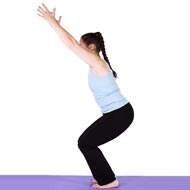- Mountain Pose
- Five pointed star pose
- Goddess Pose
- Cresent Moon Pose
- Warrior I Pose
- Warrior II Pose
- Side Angle Pose
- Triangle Pose
- High Lunge
- Revolved Side Angle Pose - Parivrtta Parsvakonasana
- Wide-Legged Forward Bend - Prasarita Padottanasana
- Lord of the Dance Pose
- Garland Pose
- Standing Split
- Revolved Triangle Pose
- Extended Triangle Pose
- Low Lunge
- Upward Forward Fold
- Big Toe Pose
- Extended Side Angle Pose
- Dolphin Pose
- Standing Forward Bend
Chair Pose (Utkatasana)
Originating as a spiritual practice or lifestyle choice in India, yoga has become popular world over as an effective means of improving the mental and physical health of an individual as well as, managing and combating diseases and chronic conditions.
Chair pose
The "Chair Pose" or "Utkatasana" is also known as the "Fierce" or "The Powerful Pose". The positioning of this asana is just like sitting on a chair except that you need to balance yourself without the use of a chair. The fierceness or power signifies what each part of the body tries to achieve. In this pose, the imaginary chair enables you to locate that strength in your body. The “Chair Pose” in yoga also helps in the stimulation of the heart and diaphragm. Performing this pose is actually quite easy, unlike other poses that seem easy but end up being difficult. The Chair Pose not only helps with stamina but also helps you perform all the standing poses by improving strength and stability. The pose also strengthens the hips and thighs.
Steps
The steps for the "Chair Pose" are as follows:
- To perform this pose, you should first start off with the "Tadasana" or "The Mountain Pose".
- Your big toes should be touching each other and your heels should be kept a little apart.
- Your lower belly should be sucked in a little to support your spine. Move your shoulder blades down and keep your chest open and thrust out across your shoulders.
- Then, take a deep breath and lift your arms over your head. You can keep your arms up with the palms joint together, facing inward, or just keep them parallel to each other. Your arms should be kept at the same level or in front of your ears.
- Bring your lower ribs towards your pelvis. Then, breathe out and bend your knees. Try to make the thighs as parallel to the ground as possible. The knees should come out in front of the feet. The torso should lean a little forward over the thighs till the torso makes a right angle with the upper part of the thighs. Your inner thighs should be parallel to each other and the heads of the thigh bones should be pressed to the heels.
- Keep the ends of your shoulders firm. Bring your tailbone down to the ground and towards your pubis to elongate the lower back.
- Remain in this pose for 30 seconds to one minute. To release from the pose, you should straighten your knees while breathing in. Then, breathe out and bring your arms to the sides of your body, back into Tadasana.
Precautions
Precautions while performing “The Chair Pose” include avoiding this pose if you suffer from low blood pressure, insomnia, and headaches. Also, practice this pose with caution if you have lower back pain. Other precautions include:
- Make sure that you go into the pose only until you can maintain the natural lumbar curve. You should stop just before your lower back pops backwards or flattens.
- If you have a shoulder injury, you should make sure to practice this pose with care. If you cannot raise your arms over your head without experiencing pain, move only within the areas where you don’t feel the pain.
- Keep your gaze straight forward if you have neck pain of dizziness.
Beginner's tip
A good beginner’s tip for the "Chair Pose" is to practice it near a wall to help you remain in the pose. You can stand with your back towards the wall and a few inches away from it. Maintain an appropriate distance so that when you come into position, your tailbone touches the wall and is supported by it.
Variations
Variations for the "Chair Pose" are performed either to ease physical limitation of the practitioner or to go deeper into the pose.
- While you bend your knees, raise the balls of your feet and bring your buttocks down onto your raised heels. Keep your arms extended forward and parallel to the floor and each other. The palms could be facing inward or down.
- You can strengthen your thighs further by squeezing a thick book or block between them while performing the pose.
- If you find it difficult to keep your heels rooted firmly to the ground roll or fold your mat a little until you can get your entire foot to touch the ground.
Benefit to body part
Benefits to the body by performing “The Chair Pose” include:
- Strengthens the spine, calves, thighs and ankles.
- Stretches the chest and shoulders.
- Stimulates the heart, diaphragm and abdominal organs.
- Helps reduce fat in the body, especially in the buttocks.
- Helpful in conditions like arthritis and joint pain.
- Improves functioning of the immune system.
The more you squat in this pose, the more resistance to gravity the body will be required to overcome. This will require a lot of strength from the quadriceps, which is one of the biggest muscles in the body. Individuals with knee problems will benefit from this pose because it strengthens the muscles that give the knees support. However, it is important that the pose is practiced gently because the bones of the lower legs can rotate with the bending of the knees and increase the chances of injury.
Therapeutic Applications
The Chair pose therapeutic applications include the following:
- Reduces flat feet.
- Helps in the stimulation of the muladhara root charka.
Preparatory Poses
The preparatory poses for chair pose include:
- Virasana (Hero Pose)
- Bhujangasana (Cobra Pose)
- Adho Mukha Svanasana (Downward Facing Dog)
Follow up poses
The follow up poses for the Chair Pose include:
- Tadasana (Mountain Pose)
- Uttanasana (Standing Forward Bend)
The secret to remaining comfortable in the Chair Pose is in the release of the thigh bone heads towards the heels. When you come into the pose keep your hands on the top of your thighs. Keep the base of your palms in the grooves of the groin and push the thighs head toward the heels. Dig your heels into the ground. You can also get a partner to use their feet or hands to press your heels into the ground firmly.



